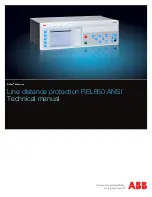
The LED indication module comprising 15 LEDs is standard in IED 670s. Its main
purpose is to present an immediate visual information for protection indications or
alarm signals.
There are alarm indication LEDs and hardware associated LEDs on the right hand
side of the front panel. The alarm LEDs are found to the right of the LCD screen.
They can show steady or flashing light. Flashing would normally indicate an alarm.
The alarm LEDs are configurable using the PCM 600 tool. This is because they are
dependent on the binary input logic and can therefore not be configured locally on
the HMI. Some typical alarm examples follow:
•
Bay controller failure
•
CB close blocked
•
Interlocking bypassed
•
Differential protection trip
•
SF6 Gas refill
•
Position error
•
CB spring charge alarm
•
Oil temperature alarm
•
Thermal overload trip
•
Bucholtz trip
The RJ45 port has a yellow LED indicating that communication has been established
between the IED and a computer.
The Local/Remote key on the front panel has two LEDs indicating whether local or
remote control of the IED is active.
4.6
How to navigate
4.6.1
Read
To read values and access information about the objects being monitored the operator
must navigate the menu tree using the arrow keys. The active submenu or value is
highlighted.
Navigation is as follows:
•
Press the right arrow key to move to the main menu.
•
Press the down arrow key to move from the Single line diagram to the desired
submenu.
•
Use the right arrow key to move downwards in the HMI tree until the desired
parameter is displayed.
Section 4
Understand the local human-machine interface
RET 670
Operator's manual
1MRK504049-UEN rev. D
21












































